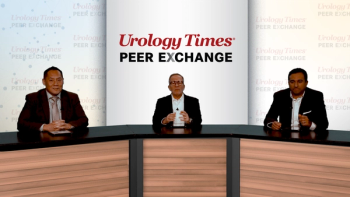
RX Review: How mitomycin for intravesical solution works in treating LG-IR-NMIBC
In this video, part 2 in a 5-part series, Nick Liu, MD, breaks down the formulation behind mitomycin for intravesical solution (Zusduri; formerly UGN-102).
Episodes in this series

In this Special Report: RX Review from Urology Times, host Rahul Mehan, MD, and Nick Liu, MD, explore the science, strategy, and patient-centered promise of mitomycin for intravesical solution (Zusduri; formerly UGN-102)—the newly FDA-approved chemoablative therapy for recurrent low-grade, intermediate-risk non–muscle invasive bladder cancer (LG-IR-NMIBC).1,2
In this clip, Liu breaks down the formulation behind the drug, a reverse thermal hydrogel that transitions from liquid to gel at body temperature, releasing mitomycin over 6 to 8 hours. This sustained exposure enables tumor ablation without surgery—offering a truly office-based, nonsurgical treatment paradigm. Drawing from findings in the phase 3 ENVISION trial, Liu highlights an 80% complete response rate at 3 months, with strong early durability (82% remaining disease-free).
Together, Mehan and Liu explore which patients stand to benefit most. For those with multifocal tumors, frequent recurrences, tumors greater than 3 cm in size, or significant medical comorbidities, mitomycin for intravesical solution represents a powerful alternative to repeat transurethral resection of bladder tumor (TURBT)—especially for older patients who wish to avoid general anesthesia, catheterization, or procedural trauma. In practice, they note, repeat TURBT is often underestimated by providers but dreaded by patients—leading to complications like bladder spasms, infections, bleeding, and rising anxiety around recurrence.
The conversation also flags potential hurdles in implementation, especially around cost and access. Drawing parallels to the challenges with UGN-101 (Jelmyto), they note that coverage, especially for Medicare patients, may shape real-world adoption.
For now, Liu and Mehan agree: Mitomycin for intravesical solution may mark a significant shift in how urologists approach LG-IR-NMIBC—offering relief, convenience, and long-term hope to a population often burdened by surgical fatigue.
More From This Series:
Our Panelists:
Rahul Mehan, MD, is the founder of East Valley Urology Center in Mesa, Arizona.
Nick Liu, MD, is the medical director of urology at Valley Health System in Paramus, New Jersey.
Mehan and Liu report no relevant disclosures.
REFERENCES
1. FDA approves mitomycin intravesical solution for recurrent low-grade intermediate-risk non-muscle invasive bladder cancer. News release. US Food & Drug Administration. Published online and accessed June 12, 2025. https://www.fda.gov/drugs/resources-information-approved-drugs/fda-approves-mitomycin-intravesical-solution-recurrent-low-grade-intermediate-risk-non-muscle
2. U.S. FDA approves UroGen’s ZUSDURI (mitomycin) for intravesical solution as the first and only medication for recurrent low-grade intermediate-risk non-muscle invasive bladder cancer (LG-IR-NMIBC). News release. UroGen. Published online and accessed June 12, 2025. https://investors.urogen.com/news-releases/news-release-details/us-fda-approves-urogens-zusduritm-mitomycin-intravesical
Newsletter
Stay current with the latest urology news and practice-changing insights — sign up now for the essential updates every urologist needs.



















